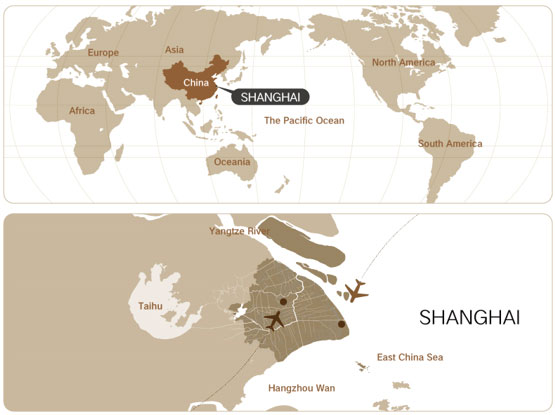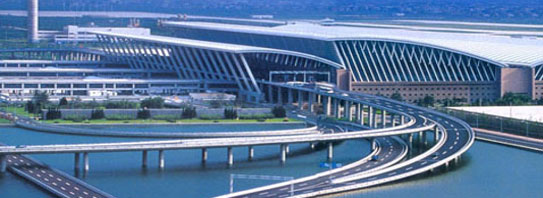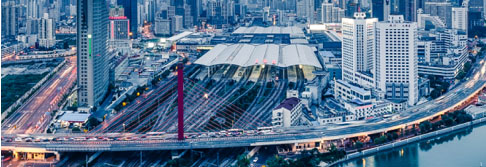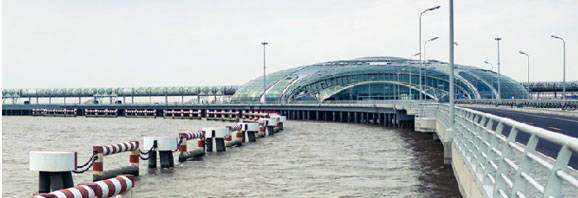Travelling guideline
General Information about Shanghai
Shanghai literally means the city by the sea. Shanghai is situated at 31° 14' north latitude and 121° 29'east longitude, on the west shore of the Pacific Ocean. It is bordered on the north and west by Jiangsu Province , on the south by Zhejiang Province, and on the east by the East China Sea . Right in the middle of China's east coastline, Shanghai is an excellent sea and river port, boasting easy access to the vast hinterland.
The city is divided into two parts by the Huangpu River: Puxi (west of the Huangpu River) and Pudong (east of the Huangpu River). Puxi is the older part of the city and hosts the majority of shops, restaurants and museums. Pudong is the modern part, and is recognized for its rather unusual yet extremely impressive high-rises such as Shanghai's tallest buildings, the Shanghai International Financial Center, Jinmao Building and the Oriental Pearl TV Tower.

Shanghai Population
Due to constant inflow of people from other parts of the country, the size of population in Shanghai keeps growing. Before Shanghai was liberated in 1949, it only had a population of 5.2 million. According to the Shanghai Statistics Bureau, Shanghai's population of residents with permanent residence registration had grown to 24.15 million, among which 14.33 million were long-term residents and 9.8 million were immigrants by the end of 2015.
Shanghai Weather & Climate
With a pleasant northern subtropical maritime monsoon climate, Shanghai enjoys four distinct seasons, generous sunshine and abundant rainfall. Its spring and autumn are relatively short compared with summer and winter. The average annual temperature is 18 degrees Celsius. The city has a frost-free period lasting up to 230 days a year. The average annual rainfall is 1,200 millimetres (about 50 inches). However, nearly 60% of the precipitation comes during the May-September flood season, which is divided into three rainy periods, the Spring Rains, the Plum Rains and the Autumn Rains.
The highest temperature is in July and August. In these two months, the temperature can reach 28 degrees centigrade. The coldest period is from the end of January to early February - usually during the Chinese Spring Festival. This awfully cold period will last for about three days but it seldom snows. From March to May, the conditions are pleasant so this is the best season for traveling. The 'Plum Rain Season' is from mid-June to early July. From late August to the first twenty days of September, the city is also susceptible to typhoons, none of which in recent years has caused considerable damage. Generally you will need a light coat and sweater in spring and short- sleeved shirts in summer. In autumn, long-sleeved shirts, sweater and coat are necessary, while sweater and overcoat are appropriate in winter.
Weather averages for Shangha | ||||||||||||
Month | Jan | Feb | Mar | Apr | May | Jun | Jul | Aug | Sep | Oct | Nov | Dec |
Average | 8 | 8 | 13 | 19 | 25 | 28 | 32 | 32 | 28 | 23 | 17 | 17 |
Average | 1 | 1 | 4 | 10 | 15 | 19 | 23 | 23 | 19 | 14 | 7 | 2 |
Precip- | 48 | 58 | 84 | 94 | 94 | 180 | 147 | 142 | 130 | 71 | 51 | 36 |
Local Currency
Chinese currency is called Renminbi (literally people's currency), often abbreviated as RMB. Issued by the People's Bank of China, it is the sole legal tender for both the Chinese nationals and foreign tourists. The unit for Renminbi is Yuan, Jiao and fen. The conversion among the three is: 1 Yuan = 10 Jiao =100 Fen. Chinese people normally refer to Yuan as Kuai, Jiao as Mao. RMB is issued in both notes and coins. The denominations of paper notes include 100, 50, 20, 10, 5, 2 and 1 Yuan; 5, 2 and 1 Jiao; and 5, 2 and 1 Fen. The denominations of coins are 1 Yuan; 5, 2 and 1 Jiao; and 5, 2 and 1 Fen.
Credit cards can be accepted at most hotels, tourist shops and some department stores.
Currency Conversion
One can change money upon arrival at the international airports of Shanghai. Also most hotels offer foreign exchange services and exchange cash and travelers cheques. The Bank of China exchanges money and travelers cheques. In China, wherever you exchange money the same day, the exchange rate is the same. Banking Hours: Mondays to Fridays, 9 a m to 5 pm.
Foreign Exchange
There are no quantitative restrictions imposed on foreign currencies, traveler's checks, or credit cards brought in.
Inbound passengers carrying foreign currencies in cash of more than 5,000 U.S. dollars should declare to the Customs. The Customs shall release it on passengers' departure upon the declaration made at the last entry.
Without last time declaration record of foreign currencies in cash, or if the recorded amount is less than what the passengers carry this time, the Customs shall release the discrepancies upon certificate issued by the Foreign Exchange Bureau or its authorized banks.
RMB
The limit of RMB allowed to bring in or take out of China is 20,000 yuan.
Voltage
Electricity is supplied at 220 volts, 50 cycles.
Airports

Shanghai's airports
Shanghai has two international airports which are about 40 km apart: Pudong International Airport and Hongqiao International Airport.
Located in Pudong District in the coastal belt of Jiangzhen, Shiwan and Zhuqiao, about 30 km from Shanghai city center, Shanghai Pudong International Airport (IATA PVG) covers an area of 40 km2. It averages some 560 flights daily, accounting for around 60 percent of all flights registered daily in Shanghai. It opens to the air traffic of 48 Chinese and foreign airlines, covering 73 international (regional) cities and 62 domestic cities. The Shanghai Maglev, the world's first commercialized maglev line, has a station at the airport and connects to Longyanglu Station on Shanghai Subway Line 2. A single trip on the line takes about eight minutes.
Located in the western suburbs of the city, Shanghai Hongqiao International Airport (IATA SHA) lies about 13 km from the city center. Before the construction of Shanghai Pudong International Airport, Hongqiao was China's busiest airport. Averaging some 540 flights daily, it mainly undertakes the functions of international airport connections and domestic departures and arrivals.
Enquiry Hotline for Shanghai's Airports: 96990
Railway Stations
Shanghai Railway Station, Shanghai Hongqiao Railway Station and Shanghai South Railway Station are known as Shanghai's three rail traffic hubs. They have a clear division of functions. Hongqiao Railway Station is specific to high-speed railway transport, while Shanghai Railway Station and Shanghai South Railway Station mainly serve EMU and ordinary train passengers.
Shanghai Hongqiao Railway Station
Located on Shenhong Road in Minhang District, Shanghai, neighboring T2 of Shanghai Hongqiao International Airport, Shanghai Hongqiao Railway Station is an integral part of the Shanghai Hongqiao Transportation Hub, a highly modernized Chinese railway passenger station, a super-large integrated railway terminal and Shanghai's largest railway station.
Shanghai Railway Station
Located on Moling Road in Zhabei District, next to Shanghai Long-distance Bus Terminal, Shanghai Railway Station is often referred to as the ‘New Passenger Station’ to distinguish it from the old Shanghai Railway Station (North Railway Station). It undertakes the receiving and dispatching of Shanghai-Nanjing intercity high-speed trains and ordinary trains bound for the north of the Yangtze River.
Shanghai South Railway Station
Located at 289 Humin Road in Xuhui District, Shanghai South Railway Station is the south gate to Shanghai's passenger railway hub, as well as an important traffic hub linking the Yangtze River Delta, Pearl River Delta, Hong Kong, Macao and other cities in southern China.
Railway Enquiry Hotline: 12306
China Railway Customer Service Center: www.12306.cn
International Cruise Passenger Terminal

Shanghai Port International Cruise Terminal
With three large berths, Shanghai Port International Cruise Terminal is the world's first cruise terminal to pass LRQA ISO 9001 Certification. It operates international regular passenger-cargo liners, visiting port cruise liners and home port cruise liners. The home port cruise lines mainly run from Shanghai to Japan and South Korea.
By constantly expanding its extended cruise business, Shanghai Port International Cruise Terminal has developed from a cruise terminal into a diversified terminal integrating such business types as duty-free commodity sales, cruise travel, catering, imported commodity supermarket, cross-border e-commerce, site leasing, bonded warehousing, ship supply, ship agency and imported commodity trade.
Add: 500 East Broadway Road, Hongkou District, Shanghai
Tel: +86 21 61819900
Fax: +86 21 61818024
E-mail: marketing@cruiseterminal.net
Website: www.cruiseshanghai.com
Wusongkou International Cruise Terminal
Located in the waters of Paotai Bay in Wusong Estuary, Shanghai, at the confluence of the Yangtze River, Huangpu River and Wenzaobang, Wusongkou International Cruise Terminal is one of the busiest international home cruise ports in the Asia-Pacific region. The terminal area has a planned coastline of 1,500 m. With a coastline of 774 m, Phase I includes two large cruise berths for 100,000-ton cruise liners and 200,000-ton cruise liners respectively.
In the follow-up project, the terminal will be extended upstream by 380 m on the basis of Phase I and two large cruise berths will be built. After the construction of the berths, the total length of the terminal will reach 1,600 m to accommodate two 225,000-ton and two 150,000-ton cruise berths, at which time the port will take on the spectacular scene of ‘four-ship berthing’.
Add: 1 Baoyang Road, Baoshan District, Shanghai
Tel: +86 21 66593501
Fax: +86 21 66593501
E-mail: wskict@126.com
Website: www.wskict.com



